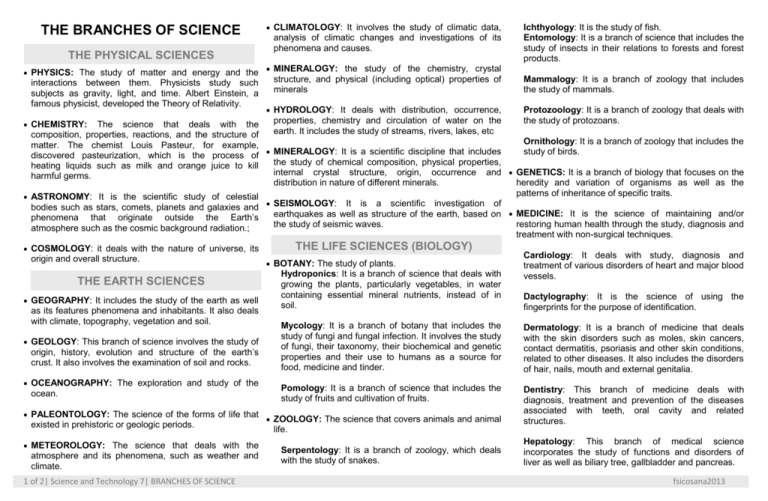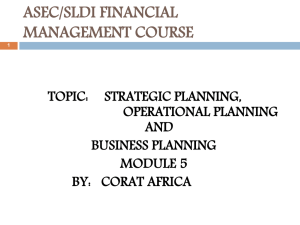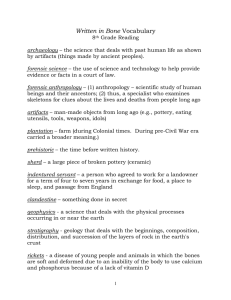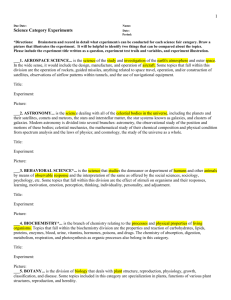The Branches of Science
advertisement

THE BRANCHES OF SCIENCE THE PHYSICAL SCIENCES CLIMATOLOGY: It involves the study of climatic data, analysis of climatic changes and investigations of its phenomena and causes. PHYSICS: The study of matter and energy and the MINERALOGY: the study of the chemistry, crystal interactions between them. Physicists study such subjects as gravity, light, and time. Albert Einstein, a famous physicist, developed the Theory of Relativity. CHEMISTRY: Ichthyology: It is the study of fish. Entomology: It is a branch of science that includes the study of insects in their relations to forests and forest products. structure, and physical (including optical) properties of minerals Mammalogy: It is a branch of zoology that includes the study of mammals. HYDROLOGY: It deals with distribution, occurrence, Protozoology: It is a branch of zoology that deals with the study of protozoans. properties, chemistry and circulation of water on the earth. It includes the study of streams, rivers, lakes, etc The science that deals with the composition, properties, reactions, and the structure of Ornithology: It is a branch of zoology that includes the matter. The chemist Louis Pasteur, for example, MINERALOGY: It is a scientific discipline that includes study of birds. discovered pasteurization, which is the process of the study of chemical composition, physical properties, heating liquids such as milk and orange juice to kill internal crystal structure, origin, occurrence and GENETICS: It is a branch of biology that focuses on the harmful germs. distribution in nature of different minerals. heredity and variation of organisms as well as the patterns of inheritance of specific traits. ASTRONOMY: It is the scientific study of celestial bodies such as stars, comets, planets and galaxies and SEISMOLOGY: It is a scientific investigation of earthquakes as well as structure of the earth, based on MEDICINE: It is the science of maintaining and/or phenomena that originate outside the Earth’s the study of seismic waves. restoring human health through the study, diagnosis and atmosphere such as the cosmic background radiation.; treatment with non-surgical techniques. THE LIFE SCIENCES (BIOLOGY) COSMOLOGY: it deals with the nature of universe, its origin and overall structure. THE EARTH SCIENCES GEOGRAPHY: It includes the study of the earth as well as its features phenomena and inhabitants. It also deals with climate, topography, vegetation and soil. GEOLOGY: This branch of science involves the study of origin, history, evolution and structure of the earth’s crust. It also involves the examination of soil and rocks. OCEANOGRAPHY: The exploration and study of the ocean. PALEONTOLOGY: The science of the forms of life that existed in prehistoric or geologic periods. METEOROLOGY: The science that deals with the atmosphere and its phenomena, such as weather and climate. 1 of 2| Science and Technology 7| BRANCHES OF SCIENCE BOTANY: The study of plants. Hydroponics: It is a branch of science that deals with growing the plants, particularly vegetables, in water containing essential mineral nutrients, instead of in soil. Cardiology: It deals with study, diagnosis and treatment of various disorders of heart and major blood vessels. Dactylography: It is the science of using the fingerprints for the purpose of identification. Mycology: It is a branch of botany that includes the study of fungi and fungal infection. It involves the study of fungi, their taxonomy, their biochemical and genetic properties and their use to humans as a source for food, medicine and tinder. Dermatology: It is a branch of medicine that deals with the skin disorders such as moles, skin cancers, contact dermatitis, psoriasis and other skin conditions, related to other diseases. It also includes the disorders of hair, nails, mouth and external genitalia. Pomology: It is a branch of science that includes the study of fruits and cultivation of fruits. Dentistry: This branch of medicine deals with diagnosis, treatment and prevention of the diseases associated with teeth, oral cavity and related structures. ZOOLOGY: The science that covers animals and animal life. Serpentology: It is a branch of zoology, which deals with the study of snakes. Hepatology: This branch of medical science incorporates the study of functions and disorders of liver as well as biliary tree, gallbladder and pancreas. fsicosana2013 PALEONTOLOGY: It is a branch of biology that deals Immunology: It deals with the study of diseases and with the study of prehistoric life, based mainly in fossils body’s immune system and its functions. of animals and plants. Etiology: It is the study of causes or origins of BIOTECHNOLOGY: It is associated with the industrial disease/abnormal condition. application of living organisms and/or biological Gynecology: It is a discipline of medicine that is Radiology: It is a medical discipline that focuses on techniques developed through basic research. concerned with disorders of women, particularly using radiation and other radioactive substances to Biotechnology is applied for producing the reproductive and sexual function and diseases of diagnose and treat various diseases. pharmaceutical compounds and research materials. It is reproductive organs. mainly applied in genetic engineering and recombinant AGRICULTURE: It is the science of cultivating the DNA technology. Nephrology: It is a discipline of medical science that ground, harvesting the crops and rearing and focuses on diagnosis and treatment of various kidney management of farming, husbandry and livestock. It is ECOLOGY: It includes the study of interrelationships disorders, including fluid and mineral balance. associated with the production of food, fiber, feed and between living organisms and their environment. other goods by systematic harvesting or growing the Therapeutics: It is the science of healing or medical PHYSIOLOGY: This branch of biology deals with the plants and rearing the animals. treatment of disease. study of physical, biochemical and mechanical functions CRANIOLOGY: This branch of science is related to the and activities of living organisms. Endocrinology: It is a branch of medical science that study of physical characteristics of the skulls of different TAXONOMY: It is the science of classifying all the living is associated with the study of function and pathology human races. of endocrine glands. things by arranging them in groups according to their ANATOMY: It is a branch of biology, related to the study relationships with each other. Forensic Science: It is a branch of medical science of structure and organization of living things. It involves that deals with establishing the evidence for legal human anatomy, plant anatomy (phytotomy) and animal CYTOLOGY: It is a branch of biological science that is proceeding. anatomy (zootomy). associated with the study of structure, origin, function and pathology of cells. Obstetrics: This branch of medicine deals with the Neurology: It is related to the structure, functioning Histology: It includes the study of structure and health and care of a woman and fetus during and disorders of nervous system including the brain, pregnancy, parturition and puerperium. spinal cord, as well as related muscles, nerves and behavior of cells and body tissues, using microscopic blood supplies. examination of tissue slices Ophthalmology: It is a branch of medical science that Myology: This science includes the study of structure MICROBIOLOGY: It is a branch of biology that is includes the study of structure, function and diseases of the eyes, such as conjunctivitis, cataracts, and function of muscles and muscle tissues. concerned with the study of structure and function of glaucoma, etc. microorganisms, including bacteria, moulds and Osteology: It is a branch of anatomy, which involves pathogenic protozoa. Pharmacology: It involves the study of the scientific study of structure, functions and Virology: It is a discipline of microbiology or drugs/medications and their nature, origin, properties pathology of bones. as well as their effects on living organisms. pathology, which includes the study of evolution, ANGIOLOGY: It is the science that includes the study of structure, classification and pathogenesis of viruses. Pathology: It is a medical discipline that is related to blood and lymph vessels and their disorders. Bacteriology: the study of bacteria in relation to cause and nature of disease. It mainly involves structural and functional changes in tissues and organs disease caused by the disease. Hematology It is a branch of medical science that includes the study of function and disease of blood as well as diagnosis and treatment of disorders of blood, lymph glands and spleen. 1 of 2| Science and Technology 7| BRANCHES OF SCIENCE fsicosana2013





